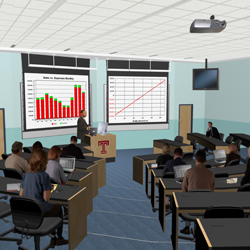|
“The technology we’re putting into Speakman this summer will be the same as what we’re putting into Alter Hall,” said Sam Hodge, professor and chairman of legal studies at the Fox School and director of the school’s Center for Innovation in Teaching. “The big difference is that every classroom in Alter Hall is designed to be almost exactly alike, meaning you’ll never have to worry about what room has what equipment or where something is located.”
Faculty members who attended the seminar saw demonstrations of several technologies that will soon be available to them, including:
Dual projection screens
“Two is better than one” — it’s an old saying that rings true when it comes to projection screens. According to Martin Doyle, an instructor in management information systems and director of database applications, having two screens in a classroom opens up new teaching techniques.
“There is less need to flip back and forth between screens,” he said. “You can now put a problem on one screen and the background information about that problem on the other screen. You can put a question on one and a student’s work on the other, or you can put a student’s solution on one and the teacher’s solution on the other.”
Having two screens also provides better viewing for students sitting in the classroom.
“Technology like this can affect the way students get involved in a class,” said Darin Kapanjie, an instructor of business pre-calculus and business calculus in the Statistics Department and faculty coordinator of Fox Online Initiatives. “Faculty members can now prepare lectures to take advantage of the technology.”
Digital annotation
Digital annotation moves faculty members and students from the dry-erase board to the PC, allowing them to write directly onto a blank computer screen or over existing content found in electronic documents. The writing can be projected onto the classroom’s dual screens for all to see and can be saved for future reference.
“Today’s students are growing up in a digital world, and they expect things to be in a digital format now,” said Rob Pred, a lecturer in statistics and an active user of digital annotation. “As soon as you erase a chalkboard the content is gone forever. With digital annotation, the content can be saved and viewed later. This accommodates all types of learners.”
Robocam and ambient microphones
Apreso Classroom, a program that records class presentations and then makes them available for viewing online, has quickly become a hit among students. The program is made possible in part by a robotic camera mounted at the back of the classroom. The camera tracks the lecturer thanks to sensors embedded into the ceiling. Audio is captured through ambient microphones in the ceiling.
“Students have told us that video quality is more important than video quantity,” said David Feeney, director of Digital Education. “This system produces very high-quality videos that students can later watch online. The videos can be speeded up or slowed down, which is good for English-as-a-second-language students.”
The ambient microphones embedded in the ceiling ensure that students can be heard on the video and eliminate the need for the lecturer to wear a wireless mike.
Putting it all together
“The real beauty of all this technology is that it works together seamlessly,” Kapanjie said. “The PCs, the cameras, the screens, the microphones … all of them are linked together into one system that is controlled through the podium.”
All of the technology being installed in Speakman and Alter halls was researched and vetted by several committees. Even the design and layout of the classrooms was examined.
“One thing we stress to faculty members is that they will make this technology their own,” DeAngelo said. “In other words, each instructor will decide for him- or herself how best to incorporate it into their classrooms and their lectures.”
“Everyone agrees that technology in itself doesn’t make students learn,” Kapanjie added. “What it does do, however, is give instructors tools to teach in a different and possibly more effective way.”
—Written by Andrew Smith for the Fox School of Business
|
